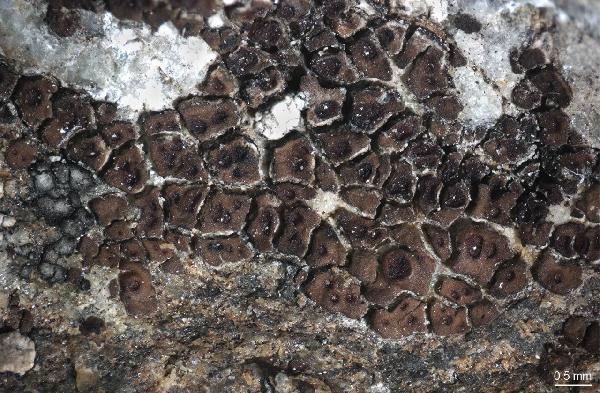Acarospora saxonica H. Magn.
K. svenska Vetensk-Akad. Handl., Ser. III, 7, 4: 182, 1929
Synonyms:
Description: Thallus crustose, episubstratic, areolate, grey-brown to dark brown, forming 1-2 cm wide patches, the areoles 0.5-0.8(-1) mm wide and 260-430 μm thick; lower side pale to blackish. Epicortex poorly developed or up to 20 μm thick; cortex paraplectenchymatous, (20-)30-40(-50) μm thick, brown in the upper 10-15 μm, colourless in lower part, with 2-5 μm wide cells; algal layer continuous, (40-)65-145 μm thick, the algal cells 10-15 μm wide; medulla up to 200 μm thick, with c. 2 μm thick hyphae. Apothecia lecanorine, 0.4-0-7 mm across, immersed in the areoles or projecting with the raised thalline margin, with a reddish brown to blackish, smooth to rough disc and an up to 60 μm wide thalline margin. Thalline exciple rich in algae; proper exciple poorly developed, 20-30 μm wide; epithecium brown, 15-25 μm high; hymenium colourless, 100-135(-150) μm high; paraphyses (1-)1.7-2(-3) μm thick at mid-level, the apical cells sometimes slightly wider; subhymenium 10-30 μm high, the hymenial gel hemiamyloid, K/I+ light blue fading to light red; hypothecium poorly developed, up to 10 μm high. Asci >100-spored, clavate, the apical dome K/I-, 80-100 x 12-17 μm. Ascospores 1-celled, hyaline, narrowly ellipsoid to almost bacilliform, 3-4 x 0.5-1 μm, almost resembling conidia. Pycnidia not known. Photobiont chlorococcoid. Spot tests: cortex and medulla K-, C-, KC-, P-, UV-. Chemistry: without lichen substances.
Growth form: Crustose
Substrata: rocks
Photobiont: green algae other than Trentepohlia
Reproductive strategy: mainly sexual
Commonnes-rarity: (info)
Alpine belt: absent
Subalpine belt: extremely rare
Montane belt: extremely rare
Dry submediterranean belt: very rare
Humid submediterranean belt: absent
Padanian area: absent
pH of the substrata:
1 2 3 4 5
Solar irradiation:
1 2 3 4 5
Aridity:
1 2 3 4 5
Eutrophication:
1 2 3 4 5
Poleotolerance:
0 1 2 3
Altitudinal distribution:
1 2 3 4 5 6
Rarity
absent
extremely rare
very rare
rare
rather rare
rather common
common
very common
extremely common
Loading data...
Occurrence data
Predictive map
Growth form: Crustose
Substrata: rocks
Photobiont: green algae other than Trentepohlia
Reproductive strategy: mainly sexual
Commonnes-rarity: (info)
Alpine belt: absent
Subalpine belt: extremely rare
Montane belt: extremely rare
Dry submediterranean belt: very rare
Humid submediterranean belt: absent
Padanian area: absent
pH of the substrata:
| 1 | 2 | 3 | 4 | 5 |
Solar irradiation:
| 1 | 2 | 3 | 4 | 5 |
Aridity:
| 1 | 2 | 3 | 4 | 5 |
Eutrophication:
| 1 | 2 | 3 | 4 | 5 |
Poleotolerance:
| 0 | 1 | 2 | 3 |
Altitudinal distribution:
| 1 | 2 | 3 | 4 | 5 | 6 |
Rarity
absent
extremely rare
very rare
rare
rather rare
rather common
common
very common
extremely common
Loading data...
Occurrence data
Predictive map







